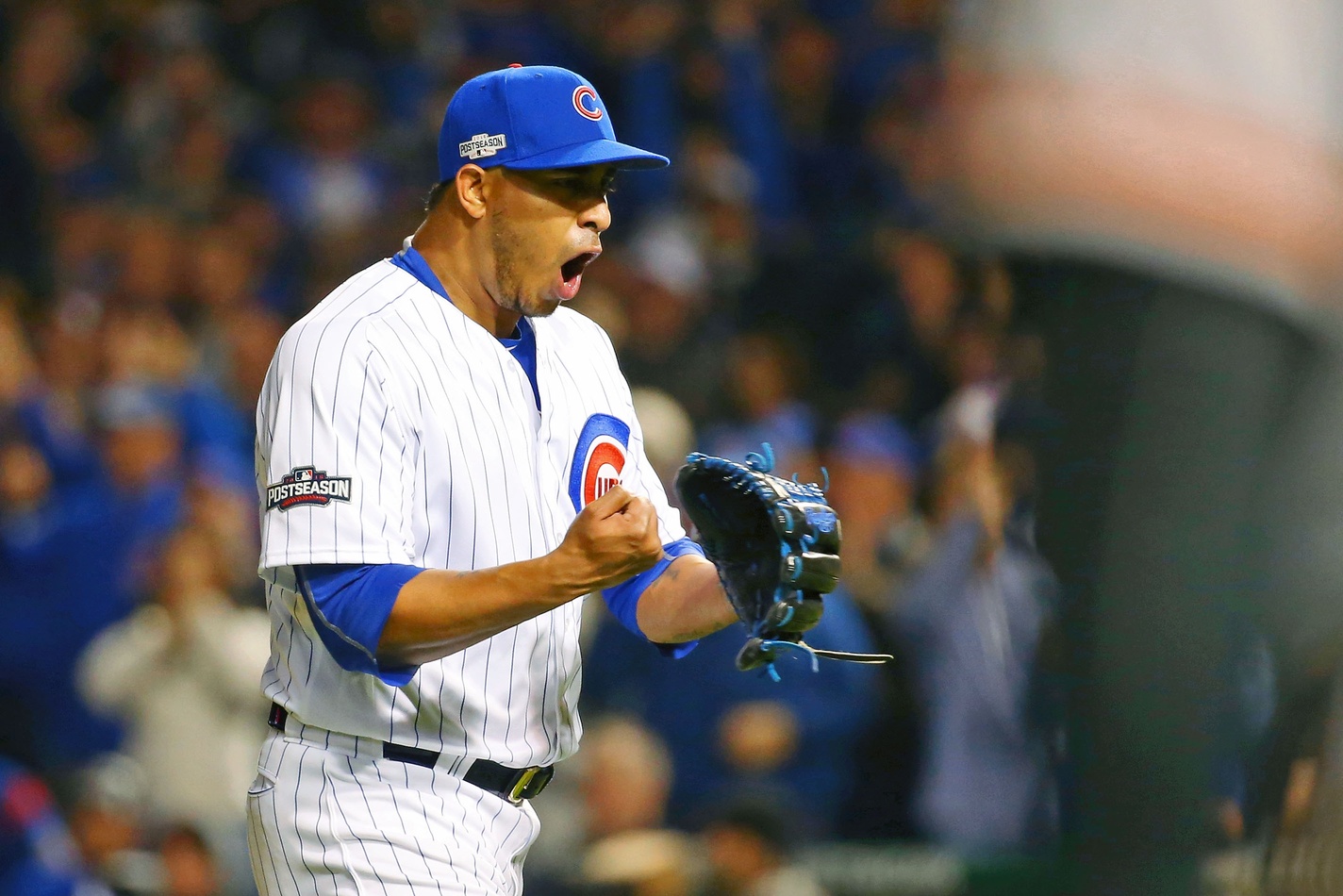2016 Stats: 3.53 ERA/3.54 FIP/2.71 DRA, 1.3 WARP
Year in Review: One of the stories that circulated during the Cubs’ World Series run was that before every game, Hector Rondon and Pedro Strop would dunk themselves in cologne and then take the field. On the surface, it sounded like a whimsical and eccentric superstition from two really fun and talented relief pitchers.
But after the way the postseason ended, I’m going to guess they were doing it because they were literally trying anything to get Joe Maddon to notice them again. Perhaps if Rondon could have figured out a way to smell like a Binny’s Beverage Depot commercial contract, he’d have done that in a heartbeat.
After taking the lion’s share of the closer duties for 2015 and experiencing the rush of ending that year’s NLDS with a strikeout of Stephen Piscotty, Rondon appeared to grab hold of the position in early 2016 with no indication that he ever wanted to give it up. He allowed no runs and all of two hits in April, and he didn’t surrender his first walk until May 15.
Due to this kind of performance, Rondon’s FIP was actually a negative number for most of the first month of the season. Which meant that, for a brief time, bringing him into the game was like the Cubs had figured out how to score runs on defense.
In fact, the early season storyline with Rondon was that he was pitching at an elite level but not registering many saves due to the fact that the Cubs’ average margin of victory was somewhere just north of the 9-0 forfeit score. In the first two months, Jim DeShaies’s number one key to the game for the Reds and Pirates was “try not to show up.”
Rondon continued performing at an outstanding level all the way through July. This is reflected on many of his final statlines for the season, with his 10.2 K/9, 1.4 BB/9, and 0.98 WHIP all setting new career bests.
However, he still lost his closer’s job when the Cubs acquired Aroldis Chapman on July 26. As Jared Wyllys reported at the time, Rondon’s reaction to this move was one of total grace and unselfishness:
“I think it’s good for our team…he’s one of the best relievers we have right now. I’m good with that. I know I did a really good job in my role. You have a chance to get that guy, better take it.”
And naturally, the universe repaid Rondon for that classy gesture almost immediately with a strain in his right triceps. Indeed, if the Cubs’ 2016 season sounds like something written by Mitch Albom, Rondon’s second half is like he rented out one chapter to Cormac McCarthy.
The Cubs initially tried to help Rondon get through the strain with rest. But after only pitching three times during the first two weeks of August, they sent him to the disabled list on the 17th. He wouldn’t return until September 6 and he clearly wasn’t the same, surrendering 8 earned runs in 7.1 innings.
And with that, the reliever who started the season looking like a world beater was reduced to an afterthought in October. Rondon finished up Game One of the NLCS in the afterglow of Miguel Montero’s grand slam, gave up Roberto Perez’s second home run in Game One of the World Series, and otherwise looked like the only endorsement he was going to secure was with whichever company used to put pictures on milk cartons.
It’s a shame because he deserved much better. But the universe remains cruel and uncaring. It’s just unprecedented that it does something like this to only one Cub instead of the whole team.
Looking Ahead: There’s really only one thing that’s going to determine which Hector Rondon we’re going to see in 2017 and that’s the health of his triceps. If it’s fine, the Cubs will have their closer issue sorted out after Chapman’s departure. If not, things look a bit murkier.
It probably doesn’t help the team’s peace of mind that the reason the Cubs got Rondon in the first place was due to an arm injury. While he was in Cleveland’s system, Rondon underwent right elbow UCL reconstruction surgery in 2010 and sustained a fracture of that joint the next year. After a couple seasons where he barely saw the mound, Cleveland eventually gave up on him and the Cubs were able to snap him up in the Rule 5 draft.
And while the issue now is with his forearm instead of the elbow, any injury to Rondon’s pitching arm has to make the team proceed with utmost caution considering that history. While spending top dollar on a free agent closer like Kenley Jansen or Mark Melancon feels like a luxury, the Cubs absolutely need to have a back-up plan in place should his arm not respond in Spring Training.
Hopefully he won’t re-strain it having to apply a “Hello, My Name is Hector” sticker when pitchers and catchers report.
Lead photo courtesy of Jerry Lai—USA Today Sports

I don’t think enough attention was paid at the time to how well Rondon was doing before his injury. Through August 2, he had a .73 WHIP, a 33% K pct (10.8K/9IP), 10:1 K:BB ratio, a .462 OPS against, and a 1.70 ERA. He was doing amazingly well, but no one seemed to notice. (I didn’t.) The fact that he took his “demotion” so gracefully, after doing so well, speaks volumes about his character.
Agreed. It was going to be the best season of his career and he was shaping up to be a hellaciously great 8th inning guy before the injury sapped his skills. If he bounces back, he’ll be a hellaciously great closer again instead.